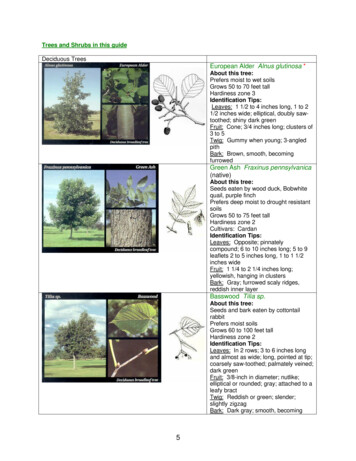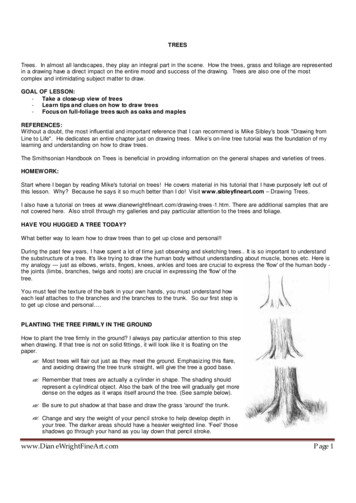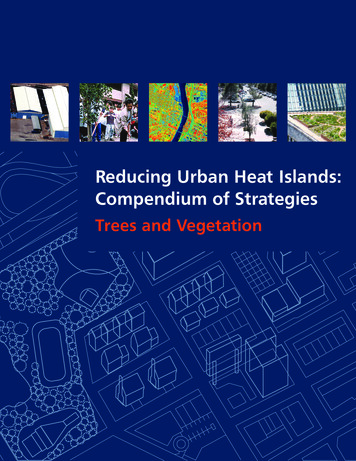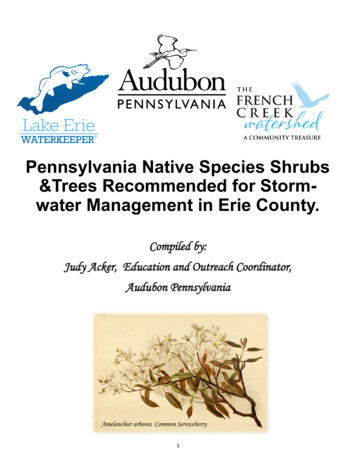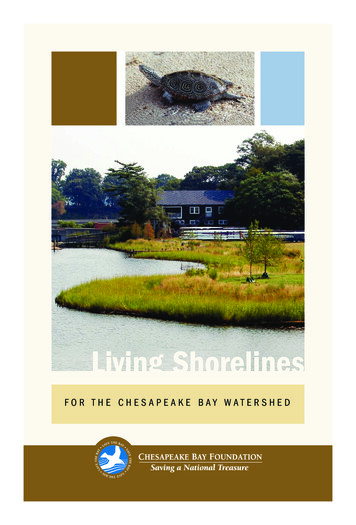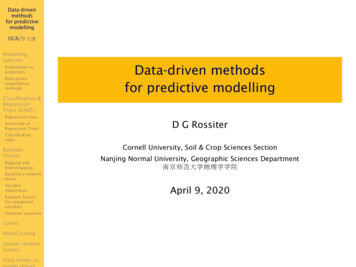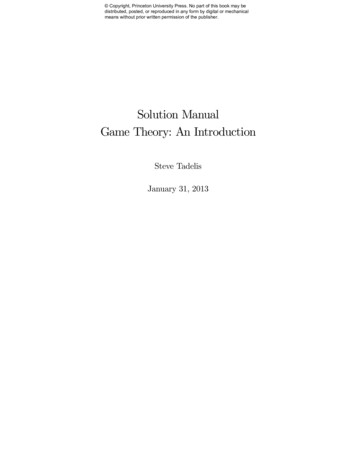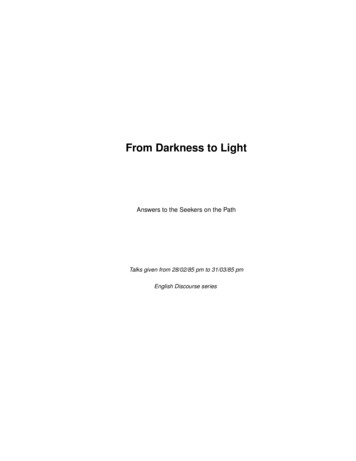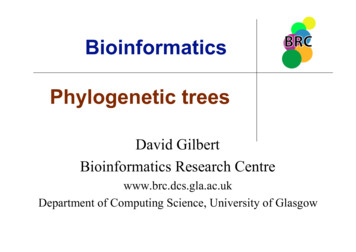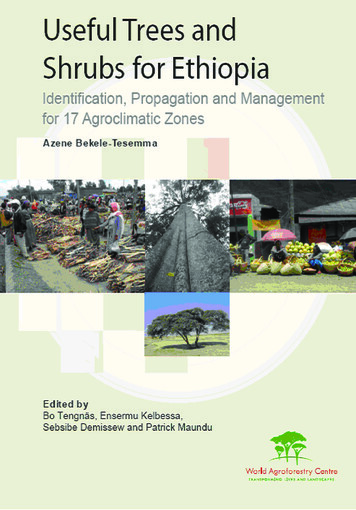
Transcription
Useful trees and shrubs of Ethiopia:Identification, Propagation andManagement for 17 Agroclimatic ZonesAzene Bekele-TesemmaEdited byBo Tengnäs, Ensermu Kelbesa, Sebsibe Demissew and Patrick MaunduRELMA in ICRAF ProjectWorld Agroforestry Centre, East Africa Region, Nairobi Kenya, 2007
THE WORLD AGROFORESTRY CENTRE, also known as the International Centre for Research inAgroforestry (ICRAF), contributes to alleviating poverty, improving food security and conserving theenvironment through the use of trees, tree products and agroforesty. The Centre pursues these goals throughresearch, education and development activities.Publisher: RELMA in ICRAF Project,World Agroforestry Centre – Eastern Africa Region Programme, P. O. Box 30677-00100, Nairobi Kenya.Publication coordination and copy editing: George N. ObanyiPrincipal illustrators: Nicholas Muema, Ann Birnie and Damtew TeferaLayout and cover design: Benson Maina MwangiPhotos: All photos by Azene Bekele-Tesemma except where indicatedCataloguing in publication dataBekele-Tesemma, A. 2007. Useful trees of Ethiopia: identification, propagation and management in 17agroecological zones. Nairobi: RELMA in ICRAF Project, 552p.ISBN 92 9059 212 5The contents of this handbook may be reproduced without special permission. However, acknowledgementof the source is requested. The photographers and artists concerned must be contacted for reproduction ofillustrations. The views expressed in this publication are those of the authors and do not necessarily reflectthe views of World Agroforestry Centre.This publication was funded by the Swedish International Development Cooperation Agency (Sida) as partof the RELMA in ICRAF Project.Printed by English Press
ContentsForeword. ivAcknowledgements. vPART IIntroductionIntroduction.2PART IISpecies by vernacular names and agroclimatic zonesVernacular names of species.16Species by agroclimatic zones.38Illustrated glossary of botanical terms.48PART IIISpecies detailsSpecies details.53PART IVSummary of uses, families and speciesFamilies and species.541Bibliography.546Species index.548
ForewordEthiopia is one of the most importantbiodiversity hotspots in the world. In1790, the first European, James Bruce ofScotland, documented only 18 plants in hisNatural History of Ethiopia. Today, nearlyseven thousand plant species, one thousandof which are endemic to Ethiopia, aredocumented in the Flora of Ethiopia (2003).Sadly, many of the species are in danger ofextinction because of rapid conversion offorest to agricultural land and over-grazing.The Regional Land Management Unit(RELMA) has published a well-known seriesof books on useful trees for Kenya, Eritrea,Ethiopia, Tanzania and Uganda. This is thelast of the series because the RELMA projectended in December 2006. We are mostgrateful to Dr. Azene and his team for thisgreat effort, which will have a lasting impact.Many of the RELMA staff, including Dr.Azene, remained at the World AgroforestryCentre (ICRAF), Nairobi.International efforts to document therich flora of Ethiopia began in earnest in1986 with the Ethiopian Flora Project ofthe Ethiopian Government through theAddis Ababa University and the SwedishGovernment through the Swedish Agencyfor Research Cooperation with DevelopingCountries (SAREC).This book is intended for use by staff involvedin agricultural extension at all levels and inthe educational system, both in specialisttraining of foresters and agriculturalists aswell as in high schools and teacher trainingcolleges.This book is the second edition of an earlierbook (1993), also led by Dr. Azene BekeleTesemma and his team. The main aim of thisextensively revised book is to benefit the ruralpeople of Ethiopia by encouraging themto grow more trees and shrubs for variousreasons, including income generation,timber, medicines, soil fertility, honeyproduction, biodiversity and watershedprotection.iv Useful Trees and Shrubs of EthiopiaIt is our hope that the book will be widelyused — both in the extension services andeducation — in Ethiopia to encouragepresent and future generation to appreciateand keep alive the great botanical heritageof Ethiopia.Professor Chin OngRELMA manager, ICRAF
AcknowledgementsThis book is a revised version of UsefulTrees and Shrubs of Ethiopia: Identification,propagation and management for pastoraland agropastoral communities, publishedin 1993 as Technical Handbook No. 35in a series developed by the Regional landManagement Unit (RELMA). Variousinstitutions and many individuals madesignificant contributions to both versions. Itis not possible to name each one of them,but we thank them all for their invaluablecontributions.During the production of the first version in1993, I was unable able to travel to Gambellaand Benishangul-Gumuz administrativeregions for logistical reasons. It was not alsopossible for me to go to the Semen mountainsof the Amhara Regional State and the TigrayHighlands because these areas were conflictzones in the fighting between Tigray People’sLiberation Front and Ethiopia’s formersocialist government. Since the study didnot cover these areas, it missed six importantagroclimatic zones and an equal number ofimportant vernacular languages. It also leftout 21 important species.I would like to take this opportunity tothank the Bureaus of Agriculture and RuralDevelopment of the two Regional StateGovernments for organizing all the logisticsthat were required to make this additionalstudy possible, and RELMA for financingthe project.At the onset of the study for this revisededition, RELMA conducted a readers’ surveythat yielded valuable feedback on the firstbook. The survey confirmed the publicationas one of the most used reference books inthe fields of agriculture and forestry. Thereaders appreciated the utility of the bookand recommended several changes to makeit even more useful.Readers recommended that each speciesbe classified by agroclimatic zones. Theyalso wanted colour photos used andadditional information on certain speciesand updated illustrations. Some of thereaders recommended that the informationbe presented in a way that would makethe book useful to other countries in theregion. All these recommendations havebeen addressed in this revised edition. Forinstance, classification by agroclimatic zonesmakes the information applicable outsideEthiopia.I would like to thank the management ofRELMA in ICRAF project for allowing meto undertake research for this book and forfinancing its production.Some of the drawings taken from thefirst version were drawn anew. We in theRELMA in ICRAF project are grateful tothe illustrators and all those who allowedus to reuse various illustrations. We areespecially grateful to Luise Gull for thedrawing of Ficus carica, and the OklahomaIntroduction
State University, Department of AgriculturalCommunications (indicated by ‘O’ in thecredits for illustrations) for allowing us to useillustrations of Discopodium penninervum,Erica arborea, Hypericum quartinianum, H.revolutum, H. roeperianum, Maesa ntata, Salix mucronata (S. subserrata),Schefflera abyssinica, Steganotaenia araliacea,Tamarix aphylla, and Woodfordia uniflora.These drawings first appeared in Families ofFlowering Plants in Ethiopia by W. C. Burger(Oklahoma Agricultural Experiment StationBulletin No. 45, O. S. U. Press, Stillwater,Oklahoma 1967).Some of the drawings from Plants of Zanzibarand Pemba by R. O. Williams (Z), and fromKenya Trees and Shrubs by I. R. Dale and P.J. Greenway (D G) used in the first editionof also appear in this revised version. Thecopyright for these illustrations still restswith the original publishers.Several original illustrations have beenprepared for this version, many based onspecimen from East African Herbarium inNairobi. We acknowledge the assistance ofthe head of the herbarium, Dr. Siro Masinde,and other staff, particularly Mr. GeoffreyMwachala, Mr. Geoffrey Mungai, Mr. A.F. Odhiambo and Ms. Brenda Nyaboke.We thank the herbarium for permission tophotograph many of the dried specimensthat are used in this book. A few more werephotographed by Dr. Ensermu Kelbesa ofAddis Ababa University Herbarium. We aregrateful for the assistance.Many thanks also go to Mr. Patrick Maunduof Bioversity International, Nairobi, whovi Useful Trees and Shrubs of Ethiopiaprovided some of the photographs and toDr. Tadesse Wolde Mariam Gole for thephotograph of Aloe vera.Dr. Mike Gilbert, Dr. J. B. Gillett andDr. Mesfin Tadesse, the Ethiopia LiaisonBotanist of the Royal Botanic Gardens,Kew, and Dr. Inga Hedberg of Uppsala gaveinvaluable help in resolving some taxonomicproblems in the first edition.I also would like to thank Professor SebsibeDemisew and Dr. Ensermu Kelbesa ofthe Addis Ababa University, who are thetechnical editors of this revised edition,and to Mr. Bo Tengnäs, advisor in the firstedition and co-editor of the second version.Mr. Maundu also made significant editorialcontributions.The technical content of this book wasdeveloped through numerous discussionswith farmers, pastoralists and manyprofessionals in the field of multipurposetrees and shrubs in eastern Africa. Withoutthe contribution of local knowledge andexperience gained over the many years fromrural communities, the content of this bookwould not be as extensive as it is.Finally, I would like to acknowledge thatno publication of this nature can be correctin every detail. The responsibility for anyremaining errors or weaknesses rests entirelywith me. I request readers to make use ofthe feedback form at the end of the bookto correct any errors or to provide me withinformation on the content of this book.Azene Bekele-Tesemma, PhDCapacity Building Advisor, EasternAfrica Region, ICRAF
PART IIntroduction
IntroductionThe aims of this bookThe tree cover in Ethiopia continues todwindle every year. The major reason forthis resource shrinkage is the increasinglyintensive use of land for crop and livestockproduction. Cutting down trees for fuelwoodand construction materials also plays a role.About 92% of the nation’s total energycomes from biomass sources, with wood andtree residues accounting for 77%. Currently,fuelwood is scarce in 75 % of the country.Another factor affecting deforestation isfailure by farmers to widely use biologicalmeasures, including planting shrubs andtrees, to control soil erosion and mitigateland degradation. There are many reasonswhy farmers have not adopted effectivesoil conservation over the years. Some ofthe reasons are of a political nature, such aslack of land and tree tenure. Others relate tolack of information — often farmers do notfarmers do not know the species best suitedto their areas.Weak extension services have also contributed.Many of the approaches and technicalsolutions promoted by the extension workershave not attracted farmers’ interest.Regrettably, forestry is not considered as ameans by which Ethiopians can fight foodinsecurity. Yet forestry is the source ofdiversified high-value industrial commoditiesthat can guarantee economic access to foodand improve people’s lives.Due to the wide variety of agroclimatic andsocio‑economic conditions in Ethiopia, Useful Trees and Shrubs of Ethiopiano uniform extension package appliednationwide can be effective. On the contrary,extension systems should engage local peoplein dialogue so that their local circumstancesare taken into account and their wishesgiven priority. So far, training of forestersand agriculturalists has not provided thesecadres with a sound knowledge of the widerange of tree species that can be grown indifferent areas and their local uses.Forestry training has focused on industrialforestry, while agriculturalists have beentrained in crop production and animalhusbandry. Knowledge of how farmers usetrees and how trees can be incorporated intofarming systems has not been given priority.As a result, few development agents (DAs)can communicate effectively with localpeople, who, in turn, remain indifferent tothe extension messages.Often, in extension work, a few exoticspecies are promoted at the expense of richindigenous flora of interest to communities.Farmers and pastoralists have accumulatedknowledge on the uses and characteristics ofdifferent tree species over many generations,but forestry policies and extension workershave given such local knowledge littleattention. In some cases, extension workersknow less about the propagation andmanagement of locally preferred species thanthe local people themselves. Consequently,farmers have little respect for the extensionagents and their advice when it comes totree or shrub identification, propagation andmanagement.
This book aims to help rectify this situationby providing information on a selection ofuseful tree and shrub species for the rangeof conditions in the 17 agroclimatic zonesfound in Ethiopia. The book is intendedfor use by staff involved in extension at alllevels. It is also suitable for use in the formaleducation system, both in specialized trainingof foresters and agriculturalists as well as inhigh schools and teacher training colleges.The is a practical handbook; not a botanicaltextbook. Therefore, efforts have been madeto present the material in simple English,although it is impossible to avoid the use ofsome technical vocabulary when describingsome of the important characteristics of thetrees and shrubs listed.A lot of information has been added tothis revised edition. Seventeen agroclimaticzones are covered, up from 12 in the firstedition. The number of languages coveredhas increased from 18 to 24.There are, however, still large gaps inthe information provided, especially innewly added species for which only basicinformation was gathered.Criteria for selectionof the speciesThere are well over 6,600 higher plant speciesin Ethiopia, including 22 that are threatened,and it would have been impossible to includethem all in this handbook. The presentselection is a compromise representingthe most important species as indicatedby farmers contacted in Amhara, Tigray,Oromia, Southern peoples, Gambella,Benshangul Guuz Harrari, Dire Dawa, Afar,Somali and Addis Ababa regional states (seemap of administrative regions on pages 10and 11) and the author’s experience.Species were also selected based on theiroccurrence in crop, grazing or communalland as well as on the knowledge offarmers, pastoralists and extension workersinterviewed by the main author. The fact thata species has been found to be useful does notnecessarily mean that it must be planted. Formany species, particularly in drier lowlandareas, protection of natural regrowth may infact be a more effective and cheaper way toensure long-term survival.A few species such as the oil-rich Jatrophacurcas and many that are good for timberare included because of their industrialvalue and potential to become investmentprojects in which farmers can be involved asoutgrowers.We have included indigenous and exoticspecies. For exotic species, we indicate if thetree has been naturalized.The species selected are almost all trees,but a number of large and small shrubs arealso included. There are, however, a fewexceptions. Tall grasses such as Arundinariaalpina, Oxytenanthera abyssinica, Arundodonax and Olyra latifolia have been included,as well as the tree fern Cyathea manniana,the climbers Rhoicissus spp., scramblers suchas Phytolacca dodecandra, the giant herb ofthe banana family Ensete ventricosum and theeconomically significant herb Aloe vera.In the selection are fruit species such as Citrusmedica, Citrus aurantifolia, Casimiroa edulisand Malus domestica.Introduction
The large woody Euphorbia species areunusual in their family but are also includedhere because they are useful and well knownin Africa.We hope that subsequent editions of the bookwill cover more species as our knowledge andcontacts with the rural communities grow.How to use this bookGeneral usage instructionsThis book can be used in a number of waysand it is largely up to the user to find outhow best to use it in his or her particularsituation. A few hints will be given here.In extension, the book can be used to identifytrees and for information on different species.In the field, local people may often indicatethat a certain species is useful and knowits name. Using the local name as an entrypoint, the extension worker can identifythe corresponding species name indicatedin the section on Vernacular Names. Afterfinding the corresponding scientific name,he or she can then compare the criteria ofthe species in the field with the identificationcriteria indicated in Part III of this book.If the criteria match, the extension agentnow informs farmers on the possible usesof the species, methods of propagation andmanagement requirements.If the vernacular name does not appear inthe list, another option is to search directlyfor the species in Part III. In this case, theextension agent should try to identify thespecies from the description, drawings andphotographs. If the text in the descriptionis difficult to understand, a study of the Useful Trees and Shrubs of Ethiopiaillustrated glossary of botanical terms (page48) should help.On other occasions, local communities maysimply indicate the various uses that theywant to get from the tree or shrub theywould like to plant. Then, they may requirethat the extension agent gives them variousoptions of species they can grow. In thiscase, the extension agent can select suitablespecies from the table summarising uses inpart IV.In other situations, users may simply wantto find out more information on a knownspecies. In this case, they should search in thealphabetical species list in Part III.Another situation may be when an extensionworker wants to know which species coulddo well in an area. In this case, the first step isto identify the agroclimatic zone. If data onrainfall and altitude are available, it is easy toidentify the zone from the table on page 9. Ifthe altitude and rainfall figures are not known,observations on the natural vegetation, cropsand soil type can be matched with thosein the table. Once the agroclimatic zone isidentified, the list of suitable species for eachagroclimatic zone (page 38) can be identifiedby referring to the section on that lists speciesby agroclimatic zone in Part II.It is also good for the extension agents tolook around and try to see which species areactually growing and how well they are doing.If the countryside is bare, it is recommendedthat they study protected forests nearchurches and preserved areas in towns andvillages as they are normally rich in species.Once a relevant list of potential species has
been made and verified with the help of localpeople, the extension worker should learnmore about the species, for instance, theirvernacular names, uses, propagation andmanagement, by studying the informationprovided in Part III. This, together with theinformation on uses in Part IV, should givethe extension worker enough knowledge togain him or her the confidence of the localpeople.In high schools and teacher training colleges,the staff and students can use this book: To identify types of trees suitable fordifferent purposes in their environmentaleducation fieldwork. As a resource document to demonstratehow seed germination time could bereduced by using suitable seed treatmentmethods. As a resource book for information onhow to raise tree seedlings of differentspecies. As a reference book for teaching aboutthe environment in subjects such asgeography, biology, agriculture, andhome science.In the technical training of foresters andagriculturalists, the book can be usedas a resource in studies of forest botany,agroforestry, silviculture and related subjects.Similar use may be possible in selectedsubjects at university level.The species descriptionsVernacular namesThe English or scientific names of treesare usually not the names farmers andpastoralists use. Farmers’ choice of speciesis often expressed in their local (vernacular)language. Even though Amharic, Ethiopia’snational language is widely understood,there is no single language that is commonlyused by all the nation’s people. Therefore, itwas decided to include as many vernacularlanguages as possible, 24.Vernacular names are given in the Part IIand again in Part III, where each speciesis discussed in detail. Knowledge of localnames is essential for any person discussingtrees with the people of a given area. Thereare two limitations to the usefulness of thesenames. Firstly, there are no standard spellingsas these are based on phonetic interpretationsof the names. Secondly, names may varybecause of the existence of several dialects ofthe same language in different areas.We request any reader finding errors oromissions in vernacular names to send usthis information.The following abbreviations oflanguages have been used in the text:localAfargna (Af ), Agewgna (Ag), Agnuakgna(Agn), Amargna (Am), Borenagna (Br),Bertagna (Brt), English (Eng), Gamogna(Ga), Gimirigna (Gm), Gumuzgna (Gmz),Guragigna (Gr), Haderigna (Hd), Kefgna(Kf ), Kembatgna (Km), Konsogna (Ks),Mejengrgna (Mjr), Nuyergna (Nur),Oromugna (Or), Sahogna (Sh), Shinashgna(Shn), Sidamigna (Sd), Somaligna (Sm),Tigrigna (Tg), and Wolaytgna (Wt).Introduction
EcologyUnder the ecology heading, information isgiven on the occurrence of each species inthe various agroclimatic zones, the altituderange, niches in the landscape, soil preference,drought resistance and other importantecological factors.Ethiopia is extremely heterogeneousecologically. This diversity has been classifiedin a number of different ways by variousauthorities. However, we have used theagroclimatic zone classification indicated byAzene Bekele-Tesemma and Hakan Sjhölm(2005) and reproduced on page 9.Unlike the previous version of this book,this revised edition indicates trees andshrubs useful for all the currently known17 agroclimatic zones of Ethiopia. Thedistribution map of these agroclimatic zonesis included for ease of reference.The list of species under “Species byAgroclimatic Zones” is useful to extensionworkers who would like to identify the plantsthat are suitable for their specific areas.However, a species being listed under a givenagroclimatic zone does not necessarily meanthat it will grow well throughout that zone.Neither does it mean that it is limited to thatagroclimatic zone either. Therefore, one mustrefer to the more detailed information givenunder each species in Part III.UsesUses, both as products and services, havebeen listed for each species in the summary Useful Trees and Shrubs of Ethiopiatable in Part IV. It should be noted thatthe information reflects “reported” uses— mainly what the rural people claim touse these plants for as cited in first-handinformation or in literature.It was not possible to verify all such reportsand statements. Sometimes uses vary fromone community to another and from onearea to the next. Thus, it is always a goodidea to verify uses when discussing any ofthe listed plants with the local people. Insome instances, the reports originated fromoutside Ethiopia. Although it was not alwayspossible to verify the usage in Ethiopia, westill included the potential uses.It should also be noted that a single tree orshrub cannot be grown for all the potentialuses at the same time. On the contrary,management of a particular tree often aimsat optimising a specific product or service.On medicinal uses, it is worth mentioningthat herbal medicine requires skilledpractitioners. Therefore, although medicinaluses have been indicated, this does notmean that anyone should start using themwithout first consulting experienced andknowledgeable people.DescriptionWhen a farmer requires a tree for a particularuse, proper identification of that tree is of thegreatest importance. The descriptions in thismanual focus first on the general appearanceof the tree and then the bark, leaves,flowers and fruit. On the page oppositeeach description are line drawings that
complement the text. With a few exceptions,in this revised version, colour photos oftrees or their parts are included to makeidentification easier. The use of specializedbotanical terminology has been kept to aminimum. Before beginning to use the textto identify a plant, the reader should refer tothe illustrated glossary on page 48.and grafting are mentioned for fruittrees. Coppicing resembles propagationbut it is actually a management practice.Hence, coppicing ability is given under“management”. The same applies for use ofroot suckers.It must be noted that there can be greatvariation in tree size and shape as well as inmany other plant characteristics dependingon the site where it is found. Therefore,the text sometimes indicates the range ofvariation that can be expected. However,certain features define that plant speciesalone. Size and scale are also indicated inthe text, but in many illustrations of typicalmature trees, an adult person is drawn besidethe tree to indicate the scale.Most trees and shrubs are propagated usingseed. Information is given on the number ofseeds per kilogram, seed storage and simpletreatment before sowing (if propagation methods is available it has beenincluded. “Seedlings” indicates that a relevantpropagation method is raising seedlingsin some sort of nursery, either on‑farm orin a central or group nursery. “Wildings”indicates that it is known that farmerspropagate a certain species by collecting andtransplanting wildings to a desired placeon their farms, or that this is one means ofpropagating the plant.“Direct sowing at site” means that a speciescan be propagated by direct sowing of seedat the desired site, and “cuttings” meanspropagation by cuttings is recommended.Cuttings is a more common vegetativemultiplication technique, while buddingSeed informationStorage of seeds should generally be avoidedfor most species. In this manual, the storageperiods indicated are not precise. This isdeliberate because loss of seed viability isa gradual process, the speed dependingon many factors, but mainly the storageconditions. Hence, only approximateindications of acceptable storage periods canbe given. If seeds are to be stored for sometime, it is always best to keep them in a cool,dry and insect-free place. Properly driedseeds can be stored in air-tight containers,such as sealed bottles or tins.Information on seeds for many of the speciespreferred by farmers is unavailable. In thesecases, the user should find out the detailslocally.ManagementDifferent management techniques allow treegrowers to optimise tree and shrub productsor services. Management techniques mayalso be applied to reduce negative effects ofthe presence of trees and shrubs, such as theshading effect on adjacent crops.Introduction
The most common management practicesare pruning of roots and branches, coppicing,lopping and pollarding. Whenever a certainmanagement technique is known to befeasible for a certain species, it is indicated.Information on the growth rate is alsoprovided under this heading.All young trees grow fast and are morelikely to survive if properly weeded and,if necessary, thinned. Since such generalmanagement requirements apply to allspecies, they have not been indicated in thedetailed information on each species.RemarksAny other useful or interesting informationthat does not fall into the above categories isincluded under “remarks”.Agroclimatic zones considered1. DRY BEREHA Dry Hot-lowlands2. MOIST BEREHA Moist Hot-lowlands3. DRY KOLLADry Lowlands 4. MOIST KOLLA Moist Lowlands5. WET KOLLAWet Lowlands 6. DRY WEYNA DEGA Dry Mid-highlands7. MOIST WEYNA DEGA Moist Mid-highlands8. WET WEYNA DEGA Wet Mid-highlands9. DRY DEGADry Highlands 10. MOIST DEGA Moist Highlands11. WET DEGA Wet Highlands12. DRY WURCH Dry Frost zones13. MOIST WURCH Moist Frost zones Useful Trees and Shrubs of Ethiopia14. WET WURCH Wet Frost Zones15. DRY ALPINE WURCH Dry Alpina-frostZones16. MOIST ALPINE WURCH Moist Alpinafrost zones17. WET ALPINE WURCH Wet Alpina-frostzone
1500- 2300 m above sea 2300-3200 m above sea 3200-3700 m above 3700 asllevellevelsea level500 - 1500 m above sealevel 500 m above sea levelANNUALPPtDRY ALPINE WURCHMOIST ALPINE WURCHWET ALPINE WURCHA: None (dry and too cold)A: None (frost limit)A: None (too cold and too wet)C: NoneC: NoneC: NoneS: Black soils, degradedS: Dark black soils, shallowS: Dark black soils, deepT: lichens, Hypericum quartinianum, T: Hypericum quartinianum, Hypericum T: Grasses, Hypericum quartinianum,Hypericum roeperianumroeperianumHypericum roeperianumDRY WURCHMOIST WURCHA: Only barley, single cropping per A: Only barley, single cropping peryearyearC: Drainage noneC: Drainage rareS: Gray soils, degradedS: Black soils, degradedT: Erica speciesDRY DEGAT: Erica, HypericumMOIST DEGAA: Barley, wheat and pulsesA: Barley, wheat and pulsesC: Traditional moisture conservation C: Few traditional terracingmeasures eg.
This book is the second edition of an earlier book (1993), also led by Dr. Azene Bekele-Tesemma and his team. The main aim of this extensively revised book is to benefit the rural people of Ethiopia by encouraging them to grow more trees and shrubs for various reasons, including income generation,
